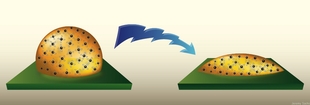Feb 21 2008
Researchers at Rensselaer Polytechnic Institute have demonstrated that liquids embedded with nanoparticles show enhanced performance and stability when exposed to electric fields. The finding could lead to new types of miniature camera lenses, cell phone displays, and other microscale fluidic devices.
“This study may open up a new vista for using nanofluids in microscale and nanoscale actuator device applications,” said Theodorian Borca-Tasciuc, a professor of mechanical engineering at Rensselaer, who led the research project.
 The contact angle of a droplet of nanofluid solution changes when exposed to an electric field. The phenomenon could lead to new types of miniature camera lenses, cell phone displays, and other microscale fluidic devices.
The contact angle of a droplet of nanofluid solution changes when exposed to an electric field. The phenomenon could lead to new types of miniature camera lenses, cell phone displays, and other microscale fluidic devices.
The manipulation of small volumes of liquid is critical for fluidic digital display devices, optical devices, and microelectromechanical systems (MEMS) such as lab-on-chip analysis systems. Most research into such systems has been conducted with regular liquids, but not nanofluids, which are liquids embedded with different nanoparticles. Nanofluids have been shown to exhibit some attractive properties, including enhanced heat transfer and capillary properties, as compared with regular, or pure, liquids.
Borca-Tasciuc’s team placed droplets of water-based solutions containing bismuth telluride nanoparticles onto a Teflon-coated silicon wafer. When an electric field was applied to the droplet, the researchers observed a strong change in the angle at which the droplet contacted the wafer. This change was much higher than that observed in liquids without the nanoparticles when tested under the same conditions.
“You use the same electrical field, but you get more change in shape with the nanofluid. We know the nanoparticles are critical in this process because without them the effect is much less strong,” Borca-Tasciuc said.
The ability to easily change the contact angle of droplets of nanofluids has potential applications for efficiently moving liquids in microsystems, creating new methods of focusing lenses in miniature cameras, or cooling computer chips. Borca-Tasciuc also envisions the research enabling new fully integrated micro- and nanoscale heat transfer systems that will not require a pump. “Our proof of concept really opens up many new exciting possibilities,” he said.
Borca-Tasciuc said his investigations into nanofluids are driven by sheer curiosity, and fostered by a strong interdisciplinary collaboration with Rensselaer Materials Science and Engineering Professor Ganapathiraman Ramanath.
“At first, we were curious to see what would happen if we introduced charged nanostructures – such as the ones we synthesize for exploring new cooling strategies in nanodevices – to the process of liquid wetting. But what started as a single, one-off experiment has now mushroomed into an exciting new research topic and expanded the scope of our collaboration,” Ramanath said
The research article, titled “Electrowetting on dielectric-actuation of microdroplets of aqueous bismuth telluride nanoparticle suspensions,” was published in a recent issue of the journal Nanotechnology.
Along with Borca-Tasciuc and Ramanath, co-authors of the paper include Rensselaer post-doctoral research associate Arup Purkayastha, and graduate student Raj K. Dash.